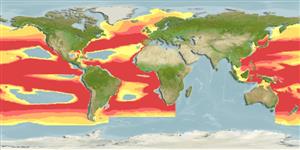Environment: milieu / climate zone / depth range / distribution range
Ecologia
marinhas batipelágico; intervalo de profundidade 0 - 2000 m (Ref. 86949). Deep-water
Tropical to temperate parts of all oceans.
Tamanho / Peso / Idade
Maturity: Lm ? range ? - ? cm
Max length : 10.5 cm SL (female)
Descrição breve
Chaves de identificação | Morfologia | Morfometria
Raios dorsais moles (total) : 5 - 7; Raios anais moles: 4 - 5. Metamorphosed females distinguished by the following characteristics: narrow snout, width of ethmoid cartilage and vomer considerably less than the distance between anterolateral tips of the lateral ethmoids and frontals; frontals short, lying posterior to the ethmoid region, dorsal margin convex; frontals separated from prootics; presence of vomerine teeth; large and nearly circular nasal foramina; presence of pterosphenoid; anterior end of illicial trough wider and shallower than the posterior end; well developed sphenotic spines; symphysial cartilage of upper jaw longer than wide; lower jaw with well developed symphysial spine; hyomandibula with double head; well developed quadrate spine, longer than articular spine; deeply notched posterior margin of opercle; long and narrow subopercle, dorsal end long and slender, tapering to a point, ventral end nearly circular; absence of first pharyngobranchial; well developed second pharyngobranchial; second hypobranchial articulates directlywith second basibranchial; caudal fin rays without internal pigmentation; illicium longer than length of escal bulb; pterygiophore of illicium cylindrical throughout length, emerging on snout from between frontal bones, anterior end exposed, posterior end concealed beneath skin; well developed first ray of dorsal fin; dorsal fin rays 5-7; anal fin rays 4-5; short and broad pectoral fin lobe, shorter than longest rays of pectoral fin; pectoral fin rays 16-19; coracoid lacking posteroventral process; simple pelvic bones, expanded distally; skin smooth and naked, without dermal spinules; darkly pigmented skin of caudal peduncle extends well past base of caudal fin (Ref. 86949).
Also mesopelagic (Ref. 10524).
Life cycle and mating behavior
Maturities | Reprodução | Spawnings | Egg(s) | Fecundities | Larvas
Bertelsen, E., 1990. Oneirodidae. p. 498-507. In J.C. Quero, J.C. Hureau, C. Karrer, A. Post, and L. Saldanha (eds.) Check-list of the fishes of the eastern tropical Atlantic (CLOFETA). JNICT, Lisbon; SEI, Paris; and UNESCO, Paris. Vol. 1. (Ref. 10524)
Categoria na Lista Vermelha da IUCN (Ref. 130435)
Ameaça para o homem
Harmless
Utilização humana
Ferramentas
Relatórios especiais
Descarregue XML
Fontes da internet
Estimates based on models
Preferred temperature (Ref.
123201): 1 - 13.3, mean 6.7 °C (based on 2192 cells).
Phylogenetic diversity index (Ref.
82804): PD
50 = 1.0000 [Uniqueness, from 0.5 = low to 2.0 = high].
Bayesian length-weight: a=0.01995 (0.00906 - 0.04395), b=3.01 (2.83 - 3.19), in cm total length, based on all LWR estimates for this body shape (Ref.
93245).
Nível Trófico (Ref.
69278): 3.8 ±0.5 se; based on size and trophs of closest relatives
Resiliência (Ref.
120179): Elevada, tempo mínimo de duplicação da população menor que 15 meses (Preliminary K or Fecundity.).
Fishing Vulnerability (Ref.
59153): Low vulnerability (10 of 100).
